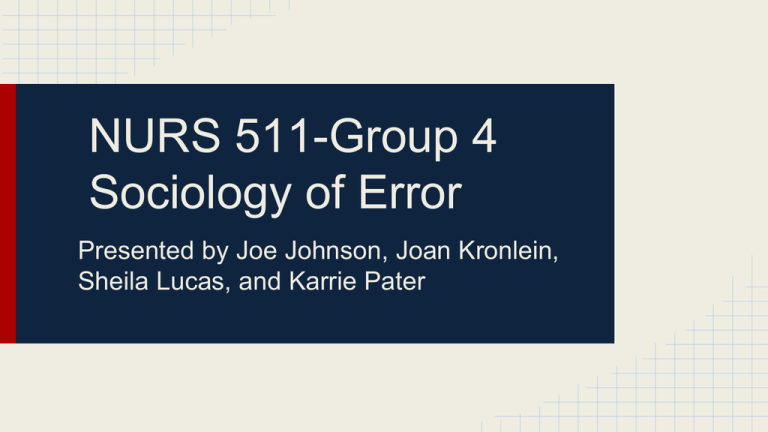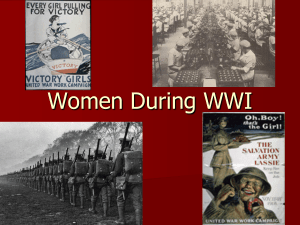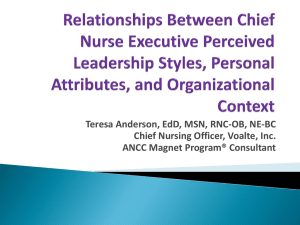NURS 511-Group 4 Sociology of Error
advertisement

NURS 511-Group 4 Sociology of Error Presented by Joe Johnson, Joan Kronlein, Sheila Lucas, and Karrie Pater Sociology of Error & Reasons for Change ● LACK OF NEW NURSE SUPPORT ○ 30% turnover rate with nurses in the first year of practice, jumped to 57% the second year of practice (Candella, 2005) ■ Reasons include poor communication and relations with management and peers, stress and feelings of inadequacy with the same workload as more experienced nurses, poor orientation and role transition, struggles with organizations and fears of harming patients ○ Institute of Medicine Recommendations to Create Nurse Residency Programs Why has this Idea Lasted? ● Poor leadership styles that are not conducive to fostering mentorship of new nurses ○ Past nursing leadership styles have been more transactional in their approach to leading ○ Mentality of “This is how I learned and I managed just fine” (“Sink or swim” mentality) ● Cost associated with creating mentorship or residency programs ○ Without organizational support, nursing is limited in how they can support their new nurses (financially) Appropriate Change Theories • • Social Capital Theory Social Cognitive Theory Social Capital Theory • A theory that would be useful in assessing the support within an environment is the Social Capital Theory (Hofmeyer, 2013). This theory was chosen because it reflects the importance of relationships and networks in healthcare. This theory would be used for assessment of the social capital within the work environment where relational problems are hidden. Social Capital Theory Why use the Social Capital Theory? 1. Simple to use 2. Easy to understand 3. Relates well to the problem described 4. Can be used at the individual and global levels 5. Identifies areas of needed change (Dudley-Brown, 1997) What is Social Capital? • A term that is not agreed on but includes “trust, mutual understanding, and shared values and behaviours that bind the members of human networks and communities and make cooperative action possible” (Hofmeyer, 2013, p. 783). “Trust and cooperation are learned behaviors, indicating that social capital can be created” (Pender, Murdaugh, & Parsons, 2011, p. 73). Social Capital: What is involved? Social Capital Theory involves: (From both the structure and cognitive levels) 1. “Analyzing existing close ties and networks within the unit”. 2. “Fostering open ties and networks within and outside the unit”. 3. “Fostering linkages and network capacity across the organization and beyond”. (Hofmeyer, 2013, p. 784) Social Capital: What is the key? According to Hofmeyer (2013) “in order to identify the presence or absence of social capital in teams of nurses, we would expect to find questions about the extent to which nurses’ trust and cooperate with each other, communicate and share [emphasis added] critical information about patient care, manage difference and disputes, and include newcomers and float nurses in the networks” (p. 785). The key is COMMUNICATION! Social Cognitive Theory Communication: In order to foster communication to increase Social Capital… • • The Social Cognitive Theory would then be used to plan the change toward a more supportive environment. Through modeling, observation, efficacy, and outcome expectations. Suggested Leadership Approach Transformational Leadership ● ● ● ● ● ● Supports a positive mentorship approach Demonstrates active listening Learning from mistakes Welcomes feedback with positive suggestion Celebrates small and large milestones Develops competency in the nursing profession ○ “Provides new nurses with a method of taking an active and participatory role in policy within a new nurses jurisdiction and power” (Valentine, 2002. p4) Strategies for Change ● Transformational leadership ● Change will be second order change (ie. a new way of doing things) ● Identify problems related to retention of new nurses ● Obtain support from nursing management, leaders and stakeholders for a program to increase new nurse retention Strategies for Change (cont.) ● Conduct a SWOT analysis of current state of current system of new nurse orientation ● Research literature to identify best practice to improve orientation/mentorship programs to increase retention of new nurses ● Form a change-group to evaluate current problems and new ways to address the problem for a positive outcome Implementation ● Develop new orientation/mentorship program to incorporate best practice ● Obtain buy-in and educate new mentors on the new process ● Initiate new process ● Evaluate results through retention percentage, and surveys conducted with all stakeholders on process. ● Adjust program as needed based on evaluations (Marshall, 2011) Implementation Challenges ● Resistance of staff to improving the orientation/mentoring process will be addressed by education about the costs of not retaining new nurses ● Concerns of the hospital regarding increased cost for orientation will be handled by explaining the costs of replacement of staff as compared to the cost of recruitment and orienting new staff ● Reluctance of staff to be involved in the new process will be dealt with by appealing to their desire to be appropriately staffed with well prepared coworkers. The Leaders Relationship with Conflict Leaders should: ● Understand ● Embrace ● Deal effectively with conflict (Weiss & Hughes, 2005) Why? ● Conflict is a stage for learning and insight ● It lends to creative solutions ● Preset mechanisms to deal with conflict can save time and lead to new positive outcomes (Weiss & Hughes, 2005) Role of Conflict and Resistance Complex systems perspective: Conflict and resistance are a part of a complex system based on key principles including: relationships, diversity, self-organization and coexistence of order and disorder. Transformational Leadership perspective: A transformational leader by definition develops the leadership capacity of an entire team. Thus, a transformational leader can cultivate an environment where a difference of opinion or debate can fuel creative thinking and consensus. The leader sees the value of different opinions and uses these differences to create effective change. References • • • ● Dudley-Brown, S. L. (1997). The evaluation of nursing theory: a method for our madness. International Journal of Nursing Studies, 34(1), 76–83. http://140.131.87.87/nursingnew/eng/data/files/201011/1290754108718416303.pdf Hofmeyer, A. T. (2013). How can a social capital framework guide managers to develop positive nurse relationships and patient outcomes? Journal of Nursing Management, 21, 782–789. doi: 10.1111/jonm.12128. Institute of Medicine. (nd)The Future of Nursing: Leading Change, Advancing Health. Report Recommendations. Retrieved From: http://www.iom.edu/~/media/Files/Report%20Files/2010/The-Future-ofNursing/Future%20of%20Nursing%202010%20Recommendations.pdf Marshall, E. (2011). Transformational leadership in nursing. New York, United States: Springer Publishing company. References cont. ● Niemeyer, K. (2013). Change theories for leadership in complex organizations. Retrieved from NURS 511 content page. ● Pender, N., Murdaugh, C., & Parsons, M. A. (2011). Health promotion in nursing practice (6th ed.). Upper Saddle River, NJ: Pearson ● Valentine, S. (2002). Nursing leadership and the new nurse. Journal Of Undergraduate Nursing Scholarship, 4(1), Retrieved from: http://0web.ebscohost.com.libcat.ferris.edu/ehost/detail?vid=5&sid=adf2c3ea-495d-4120-a06bb4e6adb033c3%40sessionmgr114&hid=127&bdata=JnNpdGU9ZWhvc3QtbGl2ZQ%3d%3 d#db=cin20&AN=2003040108 Weiss, J. & Hughes, J. (2005). Want collaboration? accept- and actively manage- conflict. Harvard Business Review, 93-101. Retrieved from:http://www.columbia.edu/itc/hs/pubhealth/isett/Session%2011/Weiss%20et%20al%20 2005%20CONFLICT.pdf ●











